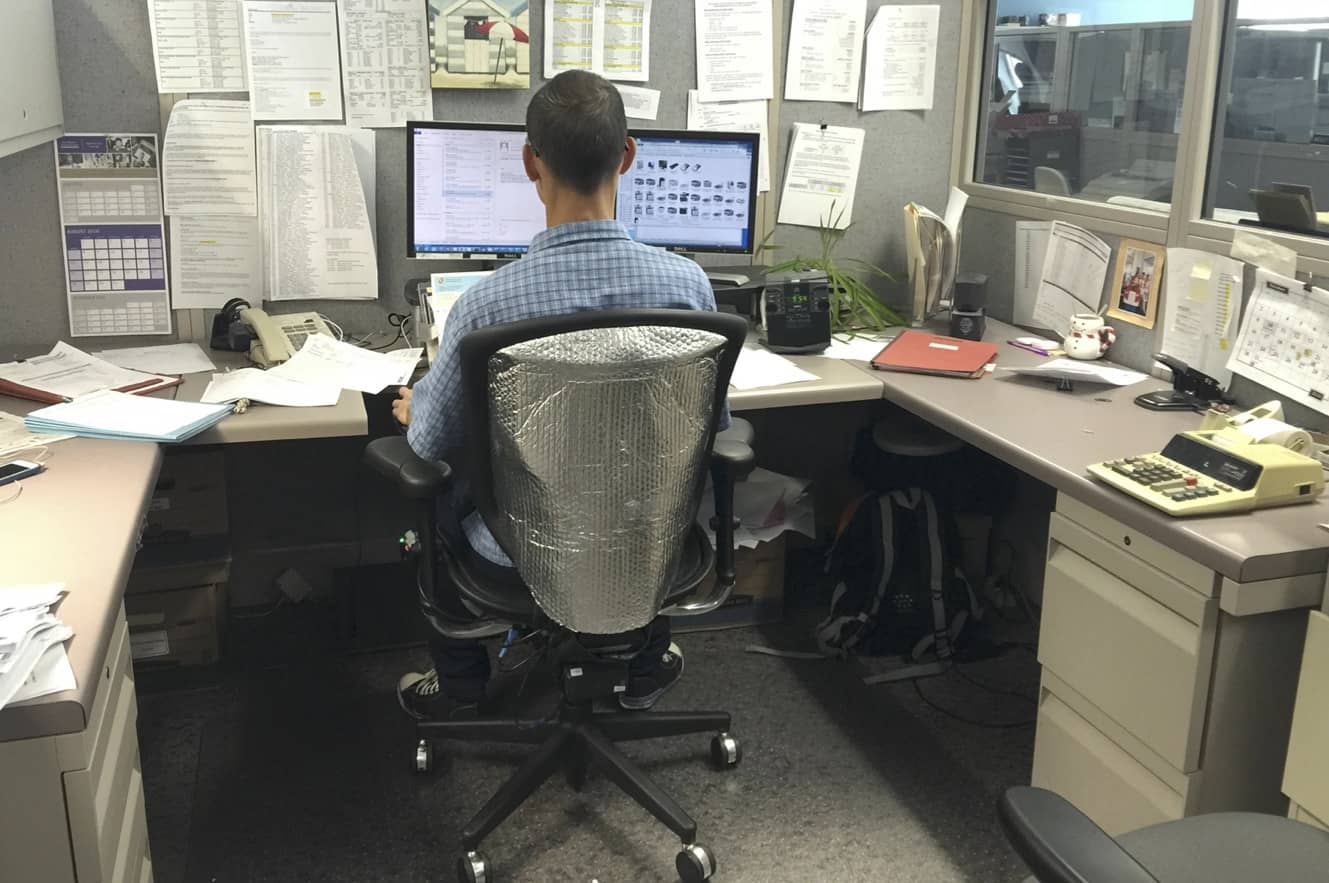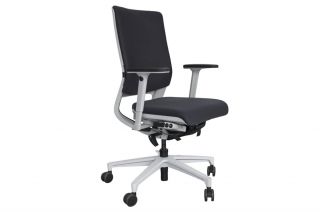
www.buildingsandcities.org/insights/commentaries/personal-comfort-systems-iot.html
Personal Comfort Systems: Using Internet of Things for Optimization

The IOT can coordinate PCS & HVAC systems to improve energy efficiency.
Joyce Kim (University of Waterloo) explains key findings and lessons arising from a Personal Comfort Systems field study using the Internet of Things. Key questions addressing the next steps for widespread adoption are posed.
Localized thermal conditioning of occupants' bodies, as provided by personal comfort systems (PCS), uses significantly less energy than conventional heating, ventilation and air conditioning (HVAC) systems while achieving greater satisfaction and individual controllability. PCS (e.g. desktop fans, heated and cooled chairs) is an untapped opportunity to reduce energy and system costs of a central HVAC system while improving occupant comfort.
The realization of this energy savings potential requires tight coordination between two systems: PCS and central HVAC systems. The Internet of Things (IoT) can provide the necessary connectivity and data to support energy-optimal interactions between PCS and the central HVAC system in a building.

Key findings about PCS include:
- Extremely high comfort satisfaction (96%) was achieved with PCS. This is far higher than the minimum 80% satisfaction requirement of ASHRAE Standard 55, which is only met in a small fraction of buildings in practice (Karmann et al., 2017).
- Individual differences in thermal preferences are satisfied with PCS by providing highly customizable microclimate in individuals' workstation without affecting others in the same space.
- Individuals' PCS control behavior closely maps to their thermal preferences (e.g. 'want cooler', 'want warmer'). This information can be used as an individualized comfort feedback for HVAC controls, as demonstrated in the development of personal comfort models (Kim et al., 2018).
- The use of PCS is often motivated by pleasurable sensation and short-term comfort needs (e.g. on first arrival), offering field evidence of both spatial and temporal alliesthesia via fast-responding local heating and cooling (Parkinson & de Dear, 2016).
- Individuals' local thermal conditions captured by the PCS embedded environmental sensors can complement the building's existing sensor network to provide more representative temperature control.
These findings provide strong support for the inclusion of PCS in building standards and rating systems, as shown in the recent adoption of Thermal Environmental Control Classification in ASHRAE Standard 55 (2020). This scheme assigns control credits to buildings with higher levels of occupant control over thermal environmental conditions.
The field study also left several questions that need answers to encourage widespread adoption and further advancements of PCS technology in the building industry:
Who are the target PCS users?
To answer this question, we need to first identify 1) who needs extra heating and/or cooling in the building and 2) where in the building the central HVAC system is ineffective in terms of delivering satisfactory thermal conditions. By understanding 'who' and 'where' the PCS will be most effective, optimal PCS deployment strategies can be developed to yield maximum comfort results. It may be unrealistic to expect everyone in a building to adopt PCS as some people are content with the thermal environment provided by the central HVAC system or they simply may not want to use PCS. Also, there is a cost involved with the purchase of PCS although it's substantially lower than the cost of a HVAC system.
Who pays for PCS?
During the field study, several participants asked about how to purchase a PCS chair. A few potential options were discussed with the building owner and facility manager, including: 1) an organizational furniture budget if the employee requires a new chair, 2) a renovation budget for the space where the chair is requested, 3) a workers' compensation scheme if the chair is considered as an ergonomic equipment and the employee meets the eligibility requirement, and 4) a personal expense if the employee is willing to pay for it. None of these options is ideal for creating a dependable and repeatable purchase process. Clarity is also needed on who is responsible for maintenance of the chair once purchased. To streamline the sales process, PCS manufacturers will need to work with key stakeholders in the building industry to develop a clear marketing strategy for PCS (e.g. is it furniture or an ergonomic item?) and create a dedicated budget for both purchase and maintenance of PCS.
How to quantify the energy benefit of PCS?
Based on the energy simulation results (Hoyt et al., 2016), the first cost of PCS can be easily offset by continual energy cost savings if the thermostat temperature setpoints are extended by PCS use. However, to verify this savings in practice, data from building systems is needed to support necessary analysis. IoT enablement of PCS is an important first step to make PCS data available. Access to HVAC and energy meter data is also needed to complete the analysis. Moreover, a common data protocol, such as Brick (Balaji et al., 2018), will play an important role in merging various data sources to quantify PCS energy benefits. As the building sector aims to achieve ambitious climate goals, the role of PCS in reducing operation carbon and increasing demand flexibility should be included in the benefit analysis.
What is the next frontier in PCS technology?
Technological progress of PCS so far has focused on enabling IoT data and communications. Now that the foundational technologies exist, the next step is to develop applications that can improve building performance, operational efficiency, energy savings, and the quality of life. One of the first applications should be software that integrates PCS with other building systems including the central HVAC system. The adoption of plug-and-play technology in the building industry can simplify this effort by automatically configuring all access points including central and distributed systems. Another interesting application is to integrate personally owned wearables into PCS operation. The heating function of PCS chairs is already used for a therapeutic reason to relieve back pain. Combined with health and fitness data from wearables, PCS can help to create personalized comfort conditions that can holistically improve individuals' productivity and wellbeing.
Answering the above questions will certainly require significant efforts from various players in the building industry. However, this is a necessary step to guide HVAC practice towards more decentralized and occupant-centric systems.
References
ASHRAE (2020). ASHRAE 55-2020: Thermal Environmental Conditions for Human Occupancy. Atlanta: American Society of Heating, Refrigerating and Air-Conditioning Engineers.
Balaji, B., Bhattacharya, A., Fierro, G., Gao, J., Gluck, J., Hong, D. ... & Whitehouse, K. (2018). Brick: Metadata schema for portable smart building applications. Applied Energy, 226, 1273-1292.
Hoyt, T., Arens, E. & Zhang, H. (2015). Extending air temperature setpoints: Simulated energy savings and design considerations for new and retrofit buildings. Building and Environment, 88, 89-96.
Karmann, C., Schiavon, S., Graham, L. T., Raftery, P. & Bauman, F. (2017). Comparing temperature and acoustic satisfaction in 60 radiant and all-air buildings. Building and Environment, 126, 431-441.
Kim, J., Bauman, F., Raftery, P., Arens, E., Zhang, H., Fierro, G. ... & Culler, D. (2019). Occupant comfort and behavior: High-resolution data from a 6-month field study of personal comfort systems with 37 real office workers. Building and Environment, 148, 348-360.
Kim, J., Zhou, Y., Schiavon, S., Raftery, P. & Brager, G. (2018). Personal comfort models: Predicting individuals' thermal preference using occupant heating and cooling behavior and machine learning. Building and Environment, 129, 96-106.
Parkinson, T. & de Dear, R. (2016). Thermal pleasure in built environments: spatial alliesthesia from contact heating. Building Research & Information, 44(3), 248-262.
Latest Peer-Reviewed Journal Content
Net zero retrofit of the building stock [editorial]
D Godoy-Shimizu & P Steadman
Co-learning in living labs: nurturing civic agency and resilience
A Belfield
The importance of multi-roles and code-switching in living labs
H Noller & A Tarik
Researchers’ shifting roles in living labs for knowledge co-production
C-C Dobre & G Faldi
Increasing civic resilience in urban living labs: city authorities’ roles
E Alatalo, M Laine & M Kyrönviita
Co-curation as civic practice in community engagement
Z Li, M Sunikka-Blank, R Purohit & F Samuel
Preserving buildings: emission reductions from circular economy strategies in Austria
N Alaux, V Kulmer, J Vogel & A Passer
Urban living labs: relationality between institutions and local circularity
P Palo, M Adelfio, J Lundin & E Brandão
Living labs: epistemic modelling, temporariness and land value
J Clossick, T Khonsari & U Steven
Co-creating interventions to prevent mosquito-borne disease transmission in hospitals
O Sloan Wood, E Lupenza, D M Agnello, J B Knudsen, M Msellem, K L Schiøler & F Saleh
Circularity at the neighbourhood scale: co-creative living lab lessons
J Honsa, A Versele, T Van de Kerckhove & C Piccardo
Positive energy districts and energy communities: how living labs create value
E Malakhatka, O Shafqat, A Sandoff & L Thuvander
Built environment governance and professionalism: the end of laissez-faire (again)
S Foxell
Co-creating justice in housing energy transitions through energy living labs
D Ricci, C Leiwakabessy, S van Wieringen, P de Koning & T Konstantinou
HVAC characterisation of existing Canadian buildings for decarbonisation retrofit identification
J Adebisi & J J McArthur
Simulation and the building performance gap [editorial]
M Donn
Developing criteria for effective building-sector commitments in nationally determined contributions
P Graham, K McFarlane & M Taheri
Reimagining circularity: actions for optimising the use of existing buildings
R Lundgren, R Kyrö, S Toivonen & L Tähtinen
Effective interdisciplinary stakeholder engagement in net zero building design
S Vakeva-Baird, F Tahmasebi, JJ Williams & D Mumovic
Metrics for building component disassembly potential: a practical framework
H Järvelä, A Lehto, T Pirilä & M Kuittinen
The unfitness of dwellings: why spatial and conceptual boundaries matter
E Nisonen, D Milián Bernal & S Pelsmakers
Environmental variables and air quality: implications for planning and public health
H Itzhak-Ben-Shalom, T Saroglou, V Multanen, A Vanunu, A Karnieli, D Katoshevski, N Davidovitch & I A Meir
Exploring diverse drivers behind hybrid heating solutions
S Kilpeläinen, S Pelsmakers, R Castaño-Rosa & M-S Miettinen
Urban rooms and the expanded ecology of urban living labs
E Akbil & C Butterworth
Living with extreme heat: perceptions and experiences
L King & C Demski
A systemic decision-making model for energy retrofits
C Schünemann, M Dshemuchadse & S Scherbaum
Modelling site-specific outdoor temperature for buildings in urban environments
K Cebrat, J Narożny, M Baborska-Narożny & M Smektała
Understanding shading through home-use experience, measurement and modelling
M Baborska-Narożny, K Bandurski, & M Grudzińska
Building performance simulation for sensemaking in architectural pedagogy
M Bohm
Beyond the building: governance challenges in social housing retrofit
H Charles
Heat stress in social housing districts: tree cover–built form interaction
C Lopez-Ordoñez, E Garcia-Nevado, H Coch & M Morganti
An observational analysis of shade-related pedestrian activity
M Levenson, D Pearlmutter & O Aleksandrowicz
Learning to sail a building: a people-first approach to retrofit
B Bordass, R Pender, K Steele & A Graham
Market transformations: gas conversion as a blueprint for net zero retrofit
A Gillich
Resistance against zero-emission neighbourhood infrastructuring: key lessons from Norway
T Berker & R Woods
Megatrends and weak signals shaping future real estate
S Toivonen
A strategic niche management framework to scale deep energy retrofits
T H King & M Jemtrud
Generative AI: reconfiguring supervision and doctoral research
P Boyd & D Harding
Exploring interactions between shading and view using visual difference prediction
S Wasilewski & M Andersen
How urban green infrastructure contributes to carbon neutrality [briefing note]
R Hautamäki, L Kulmala, M Ariluoma & L Järvi
Implementing and operating net zero buildings in South Africa
R Terblanche, C May & J Steward
Quantifying inter-dwelling air exchanges during fan pressurisation tests
D Glew, F Thomas, D Miles-Shenton & J Parker
Western Asian and Northern African residential building stocks: archetype analysis
S Akin, A Eghbali, C Nwagwu & E Hertwich
Join Our Community

The most important part of any journal is our people – readers, authors, reviewers, editorial board members and editors. You are cordially invited to join our community by joining our mailing list. We send out occasional emails about the journal – calls for papers, special issues, events and more.
We will not share your email with third parties. Read more



Latest Commentaries
Building-Related Research: New Context, New Challenges
Raymond J. Cole (University of British Columbia) reflects on the key challenges raised in the 34 commissioned essays for Buildings & Cities 5th anniversary. Not only are key research issues identified, but the consequences of changing contexts for conducting research and tailoring its influence on society are highlighted as key areas of action.
Lessons from Disaster Recovery: Build Better Before
Mary C. Comerio (University of California, Berkeley) explains why disaster recovery must begin well before a disaster occurs. The goal is to reduce the potential for damage beforehand by making housing delivery (e.g. capabilities and the physical, technical and institutional infrastructures) both more resilient and more capable of building back after disasters.